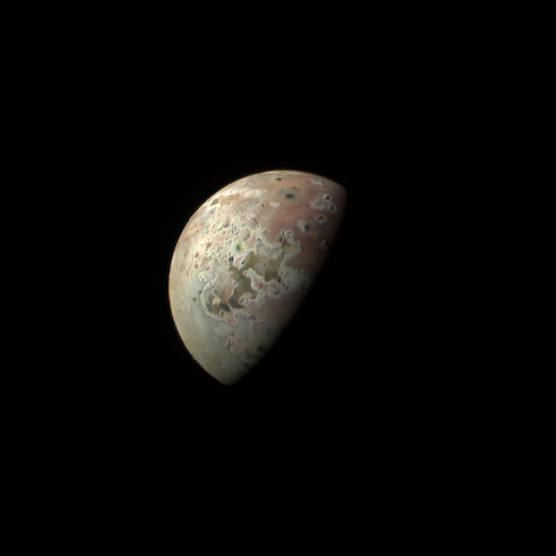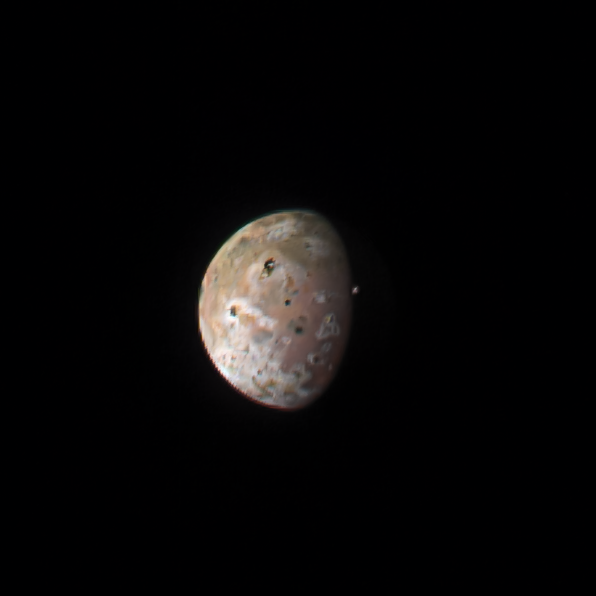It looks like you're using an Ad Blocker.
Please white-list or disable AboveTopSecret.com in your ad-blocking tool.
Thank you.
Some features of ATS will be disabled while you continue to use an ad-blocker.
share:
The images were taken on May 16 as Juno made its closest pass of Io while on its elongated orbit of Jupiter , in late December this year Juno will
make an even closer pass expected to be just 932 miles from the volcanic Moon.


Io is about the size of our Moon , its volcanism is driven by a tug of war between the gravity of Jupiter and the planet's larger Moons which stretches IO and creates the internal heat driving the volcano's.


“Io is the most volcanic celestial body that we know of in our Solar System,” Scott Bolton, Juno principal investigator from the Southwest Research Institute in San Antonio, said in a statement.
“By observing it over time on multiple passes, we can watch how the volcanoes vary – how often they erupt, how bright and hot they are, whether they are linked to a group or solo, and if the shape of the lava flow changes.”
“We are entering into another amazing part of Juno’s mission as we get closer and closer to Io with successive orbits. This 51st orbit will provide our closest look yet at this tortured moon,” said Bolton.
“Our upcoming flybys in July and October will bring us even closer, leading up to our twin flyby encounters with Io in December of this year and February of next year, when we fly within 1,500 kilometers of its surface. All of these flybys are providing spectacular views of the volcanic activity of this amazing moon. The data should be amazing.”
www.iflscience.com...
Io is about the size of our Moon , its volcanism is driven by a tug of war between the gravity of Jupiter and the planet's larger Moons which stretches IO and creates the internal heat driving the volcano's.
Man oh man that's a cool looking moon. Wish I could go there and explore it.
a reply to: NoCorruptionAllowed
I would like to see a mission to Europa or Enceladus , both moons create energy from the gravitational pulls from their host planets aswell , but got huge oceans under a think layer of ice that protects possible life cells from radiation.
I would like to see a mission to Europa or Enceladus , both moons create energy from the gravitational pulls from their host planets aswell , but got huge oceans under a think layer of ice that protects possible life cells from radiation.
a reply to: TheGreazel
There's one on its way to visit Ganymede, Europa and Callisto mate , it'll take a few years to get there though.
www.abovetopsecret.com...
There's one on its way to visit Ganymede, Europa and Callisto mate , it'll take a few years to get there though.
www.abovetopsecret.com...
Io is my favorite moon in the solar system because of its volcanism. Can't wait for more pictures. Great post!
a reply to: TheGreazel
Just think maybe one day will be able to use machines to harness the energy of those moons send that energy back to us here on earth. People say there’s no such thing as a perpetual motion machine. But I’ve always seen the solar system and the movements of planets and moons as a gigantic perpetual motion machine.
Just think maybe one day will be able to use machines to harness the energy of those moons send that energy back to us here on earth. People say there’s no such thing as a perpetual motion machine. But I’ve always seen the solar system and the movements of planets and moons as a gigantic perpetual motion machine.
edit on 21-5-2023 by scraedtosleep because: (no reason given)
a reply to: musicismagic
more than likely to cold not to hot
as expected though the volcanos can be hot
Io: A guide to Jupiter's volcanic moon
great thread Gortex
more than likely to cold not to hot
Temperature: Io's surface temperature averages about minus 202 degrees Fahrenheit (minus 130 degrees Celsius), resulting in the formation of sulfur dioxide snowfields.
as expected though the volcanos can be hot
But Io's volcanoes can reach 3,000 degrees F (1,649 degrees C). Io is often referred to as a celestial body of fire and ice.
Io: A guide to Jupiter's volcanic moon
great thread Gortex
edit on 000000p3103America/Chicago521202305 by UpThenDown because: (no reason given)
I love how very different Jupiter's and Saturn's moons are. There are icy moons, volcanic moons, and the very unique Titan with its atmosphere, seas,
and dunes. Really hope to see detailed close-ups in the coming years and decades.
originally posted by: gortex
The images were taken on May 16 as Juno made its closest pass of Io while on its elongated orbit of Jupiter , in late December this year Juno will make an even closer pass expected to be just 932 miles from the volcanic Moon.
“Io is the most volcanic celestial body that we know of in our Solar System,” Scott Bolton, Juno principal investigator from the Southwest Research Institute in San Antonio, said in a statement.
“By observing it over time on multiple passes, we can watch how the volcanoes vary – how often they erupt, how bright and hot they are, whether they are linked to a group or solo, and if the shape of the lava flow changes.”
“We are entering into another amazing part of Juno’s mission as we get closer and closer to Io with successive orbits. This 51st orbit will provide our closest look yet at this tortured moon,” said Bolton.
“Our upcoming flybys in July and October will bring us even closer, leading up to our twin flyby encounters with Io in December of this year and February of next year, when we fly within 1,500 kilometers of its surface. All of these flybys are providing spectacular views of the volcanic activity of this amazing moon. The data should be amazing.”
www.iflscience.com...
Io is about the size of our Moon , its volcanism is driven by a tug of war between the gravity of Jupiter and the planet's larger Moons which stretches IO and creates the internal heat driving the volcano's.
In the second picture there appears to be something above the ground just inside the sunset line, to the right. Could that be a orbiting asteroid?
new topics
-
Official denial
Diseases and Pandemics: 2 hours ago -
MEGA - Let's Make Europe Great Again
Other Current Events: 2 hours ago -
Hamas and Other Islamist Terrorist Groups Announce Support of US Campus Anti-Israel Protests
Education and Media: 3 hours ago -
Psychotronic Operation Rwanda Who Wants To Be A Refugee?
ATS Skunk Works: 4 hours ago -
AI phrenology
Science & Technology: 11 hours ago
top topics
-
4/27/24 New Jersey Earthquake
Fragile Earth: 16 hours ago, 8 flags -
AI phrenology
Science & Technology: 11 hours ago, 4 flags -
Psychotronic Operation Rwanda Who Wants To Be A Refugee?
ATS Skunk Works: 4 hours ago, 3 flags -
Hamas and Other Islamist Terrorist Groups Announce Support of US Campus Anti-Israel Protests
Education and Media: 3 hours ago, 3 flags -
MEGA - Let's Make Europe Great Again
Other Current Events: 2 hours ago, 2 flags -
Official denial
Diseases and Pandemics: 2 hours ago, 1 flags
active topics
-
Hamas and Other Islamist Terrorist Groups Announce Support of US Campus Anti-Israel Protests
Education and Media • 6 • : Shoshanna -
Hate makes for strange bedfellows
US Political Madness • 59 • : network dude -
Official denial
Diseases and Pandemics • 6 • : Lochid -
Canada caught red-handed manipulating live weather data and make it warmer
Fragile Earth • 28 • : stonerwilliam -
What allies does Trump have in the world?
ATS Skunk Works • 8 • : Freeborn -
MEGA - Let's Make Europe Great Again
Other Current Events • 9 • : Freeborn -
Psychotronic Operation Rwanda Who Wants To Be A Refugee?
ATS Skunk Works • 4 • : stonerwilliam -
Joe Biden Facing Criminal Charges In Ukraine
Mainstream News • 96 • : Justoneman -
AI phrenology
Science & Technology • 15 • : Hecate666 -
-@TH3WH17ERABB17- -Q- ---TIME TO SHOW THE WORLD--- -Part- --44--
Dissecting Disinformation • 714 • : Justoneman

